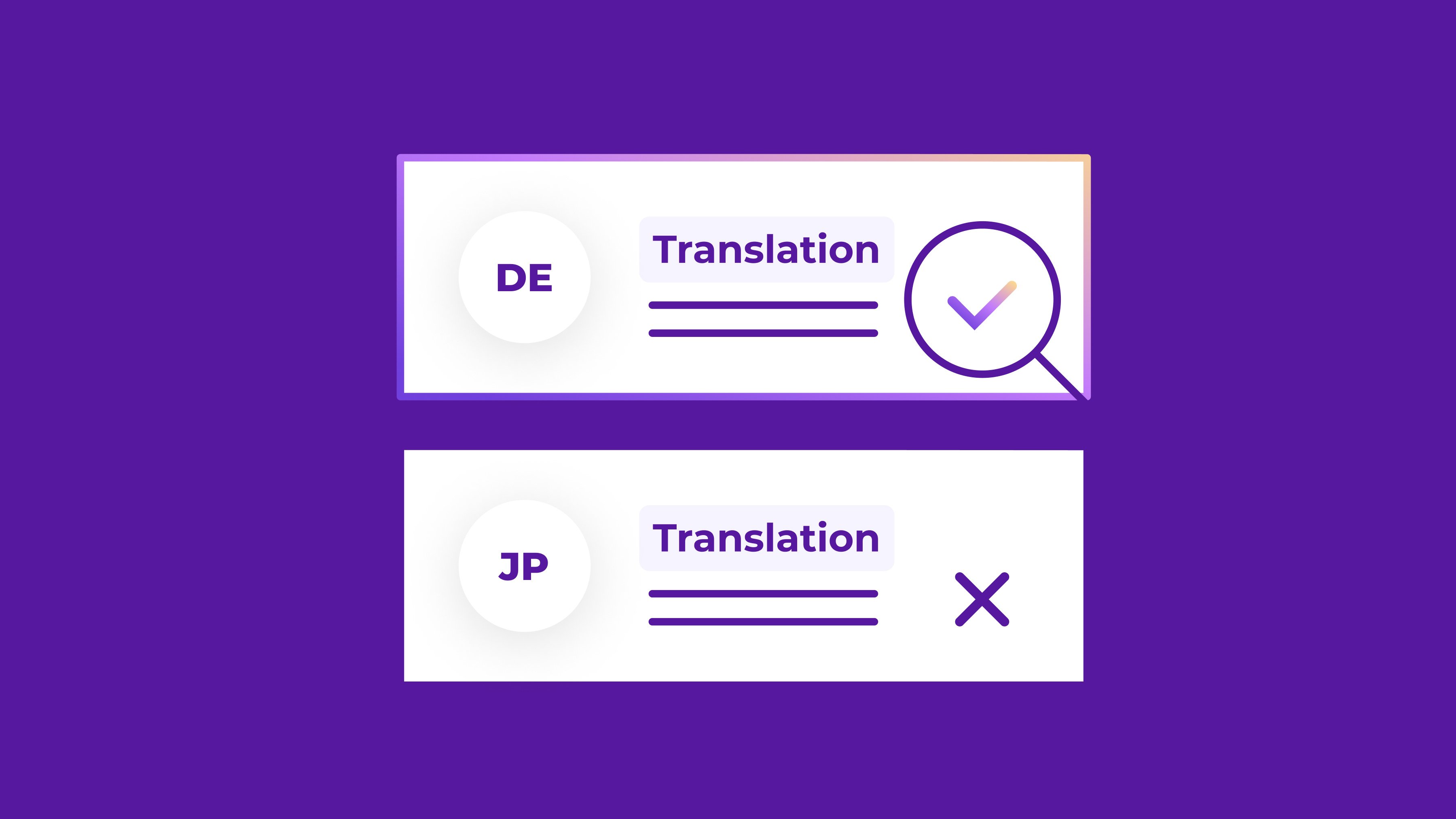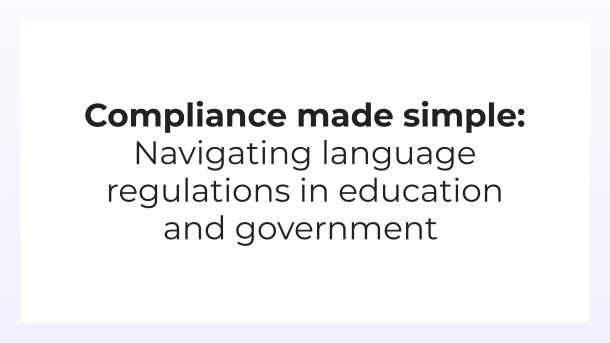What is machine translation, and how can it speed up market entry?
What is machine translation? It’s a good question since this technology has been around since 1949. Machine translation, or the automated translation of text from its source language to another via computer software, looks a lot different today than it did decades ago, and it’s continuing to evolve rapidly.
If you still picture Babelfish from the early 2000s when you think of machine translation, you might be surprised by how accurate, convenient, and fast today’s technology is. Machine translation can now quickly and reliably help businesses launch in new global markets.
It’s no longer a question of whether you should use machine translation but of when and how. But first, let’s answer the question “What is machine translation?” and dispel some common myths about it.
What is machine translation?
Put simply, machine translation is a process where artificial intelligence (AI), machine learning, and algorithms automatically translate text or speech from one language to another—without a human linguist. During this process, the original text or language is called the source language, and the language you’re translating into is called the target language.
Different types of machine translation methods
There are a handful of different approaches to machine translation, and each one works slightly differently.
Rule-based machine translation
With rule-based machine translation (RBMT), the AI system uses linguistic rules and bilingual dictionaries to translate text. The linguistic rules tell the AI how it needs to translate words or phrases from the source language into the target language to preserve the meaning.
RBMT requires human translators to create and maintain grammar and language rules, as well as perform a lot of human editing. Today, RBMT isn’t very common due to the need for human involvement and low translation quality.
Statistical machine translation
Statistical machine translation (SMT), which requires less human input than RBMT, instead uses machine learning algorithms to complete translations. SMT analyzes a large number of existing human translations to identify patterns. These patterns then allow the system to develop statistical models to predict how to translate the text.
SMT is an improvement over RBMT but still runs into issues with accuracy.
Syntax-based machine translation
Syntax-based machine translation (SBMT), a type of SMT, relies on grammatical rules and sentence structures to translate text. Analyzing example sentences and their corresponding translations, or language pairs, allows SBMT to include syntax rules in the statistical translation models it builds.
This approach allows SBMT to translate complex text more accurately, but it requires a large number of example words and phrases to train on.
Neural machine translation
Neural machine translation (NMT) learns how to translate languages using a machine learning method called neural networks. A neural network works similarly to a human brain by passing data through several interconnected nodes. This system allows NMT to work with large datasets, as each node works to decode the source language and encode the target language.
Because NMT translates whole sentences instead of single words or phrases, its translations tend to sound more natural. Since many consider it to be the most accurate machine translation method, most language translation technologies, including Smartling, rely on NMT.
Hybrid machine translation
Hybrid machine translation (HMT) uses two or more machine translation methods to improve the results you might see from a single translation solution. Most often, HMT combines RBMT and SMT models, but it can also use NMT models.
For example, HMT might use SMT to identify and translate patterns, RBMT to translate certain linguistic nuances, and NMT to create more accurate and natural-sounding translations.
What is a computer-assisted translation tool?
Used alongside machine translation tools, computer-assisted translation (CAT) tools automate tasks like editing and managing translations. To do this, users input text into the CAT tool, which then divides the text into paragraph, sentence, or phrase segments. The tool then saves these segments in a database that the machine translation software can access.
Since CAT software speeds up the translation process, many businesses use these tools to automate their translation and localization projects.
3 primary benefits of machine translation

Smartling Translate allows you to quickly create on-brand, custom translations in seconds. (Source: Smartling
Localizing user experiences is more important than ever—CSA Research found that 76% of consumers prefer to shop in their own language. Thankfully, machine translation offers several benefits that make it ideal for businesses that are trying to reach new markets:
- Increased speed: Machine translation software, like Smartling’s NMT Hub or Smartling Translate, improves efficiency by automating the manual tasks involved in the translation process. Machine translation can cover up to 7,000 words per day, while a human translator can translate an average of 2,000 to 3,000 words per day.
- Lower costs: While translation rates typically land between $0.15 and $0.30 per word for a human translator, machine language translation costs much less—around $0.0012 to $0.0050 per word.
- Convenience: Numerous machine translation services now exist, including DeepL, Google Translate, Amazon Translate, and Smartling. These services make using machine translation for personal projects, or even for multi-language business localization projects, far more convenient.
The benefits of machine translation help businesses reach new markets more quickly with localized content.
The history of machine translation
Machine translation’s history started in 1949 when it appeared in Warren Weaver’s Memorandum on Translation. Not long after, World War II prompted a need for faster military document translation, so researchers like Yehoshua Bar-Hillel began experimenting with machine translation in 1951.
Putting machine translation into practice, however, was difficult. The first models, like the Georgetown IBM Experiment, relied on a set of linguistic rules. Along with this reliance on professional translators and rules, the machine translation systems of the 1950s required more data processing power and storage than the current technology could provide.
Machine translation development continued in the 1960s and ‘70s with SYSTRAN and METEO. However, since these systems still used rule-based translation, researchers continued to struggle to develop a tool that could compete with human translators.
The 1990s saw the rise of SMT, thanks to the availability of large language training data sets. SBMT systems also gained popularity, and both new approaches to machine translation led to improved accuracy and higher-quality translations.
In the late ‘90s and early 2000s, software like Babelfish and Google Translate, along with the Internet’s arrival, gave more people access to machine translation. And in 2016, Google introduced NMT, prompting Microsoft and Amazon to follow close behind. Modern machine translation quality is now even closer to that of human translators.
"[Neural machine translation] is gradually eliminating the demarcation between human and machine translation,” says Jack Welde, founder and CEO of Smartling. “It is creating more opportunities for a productive closed loop between machine and human, including machine-enabled tools that make the human more productive and human inputs that make the machine more accurate going forward.”
Did you know? The theories behind machine translation created the field of natural language processing.
3 machine translation myths
Though machine translation has existed for over half a century, misunderstandings are still prevalent. Let’s clear up some common machine translation myths.
Myth 1: Machine translation will replace human translators
Fact: There will always be a need for human translators in the process to add cultural relevance and nuance that machine translation cannot reach.
Sure, machine translation may take some of the work off human translators in certain circumstances. But higher-visibility, detailed, and more complex content like web pages, mobile apps, or even a business’s marketing collateral requires human post-editing to ensure accuracy and relevance. Additionally, if your target language is less common, machine translation may produce inaccurate translations due to a lack of training data in that language.
Machine translation may also struggle to translate industry-specific content—especially if specialized datasets and models are unavailable. This is where human linguists with professional or academic experience shine. They can edit machine translation results so the translated text is clear and accurate.
Alternatively, you could look for a machine translation service like Smartling that lets you train a custom machine translation engine using glossaries and translation memory to reduce errors and maintain brand standards.
Myth 2: All machine translation software produces the same quality of translation
Fact: Quality depends on the machine translation engine and the language in question.
It may surprise you to know that machine translation technology’s accuracy depends not only on the engine you use but also on your target language.
For example, PCMag tested the accuracy of different machine translation engines when translating multiple languages and found that ChatGPT was the most accurate for translating Polish, but Google Translate was the best for translating Tagalog. The answer to which machine translation engine is best still continues to change as updates roll out and engines train on new data sets.
Smartling’s NMT Hub selects from multiple engines to improve translation quality. (Source: Smartling)
Smartling’s NMT Hub ensures that you always get the most accurate translation possible by automatically routing your content to the machine translation engine that delivers the best results based on your project. The NMT Hub selects between models like Amazon Translate, Watson Language Translator, GPT, and PROMT, resulting in up to 350% higher-quality translations.
Myth 3: The machine translation process doesn't require any human intervention
Fact: Contextual verification requires post-editing.
Even NMT is hit-or-miss when it comes to context, so human editors are necessary to ensure that the intended meaning is still present in your freshly translated content.
On top of this, how machine translation works can potentially create biased results. This is largely due to gender and cultural biases, as well as other biases in the training data. For example, machine translation systems tend to translate gendered words into the corresponding masculine versions due to the large representation of masculine figures and speech in the data.
For spoken translations, this is an even larger issue. The Stanford Social Innovation Review notes that Google’s speech recognition software recognizes male voices 13% more accurately than female voices. The disparity in accuracy grows further if the voice belongs to a woman of color or a user who speaks with an accent.
Human input is necessary to reduce and remove bias—and machine translation technology requires access to diverse, unbiased datasets when possible.
Finding the right translation mix
Machine translation quality isn't up to par with professional translators yet. This is especially true for certain types of content, like legal contracts, where accuracy is a must, or advertisements, which require creativity to convey a message in a small amount of space.
Here’s when to use machine translation versus human translation—as well as when you should use both.
Machine translation
With recent advancements, including NMT, machine translation is now ideal for the following projects:
- Support tickets and messages
- User reviews
- User manuals with a high volume of content
- Internal documentation
- Knowledge bases and help guides
- Website footers
Human translation
You’ll want a pair of human eyes when it comes to translating these types of content:
- Website home pages and landing pages
- Blog posts
- Press releases
- Advertisements
- Email marketing campaigns
Speed up global expansion: Read our guide to learn how to translate your website or mobile app with a translation management system.
AI and human translation
Working on technical documents or content? It’s worth using machine translation software to create your initial translation and then having a human translator review the results for this content:
- Commercial contracts
- Patents
- Terms and conditions
- Marketing materials
- SEO content
- Product titles and descriptions
Use Smartling’s powerful machine translation to deliver impactful experiences
Machine translation has come a long way since its inception in 1949. Businesses can now rely on tools like Smartling Translate and the NMT Hub to deliver high-quality localized content in less time and for a fraction of the cost of human translation.
For projects that require more nuance and industry-specific expertise, Smartling also offers AI-powered human translation. This approach nets you the best of both worlds—quick machine translation results followed by a human review for optimal accuracy and relevance.
Translate billions of words in minutes with Smartling’s NMT Hub, or watch our five-minute demo to discover what our translation services can take off your plate.






